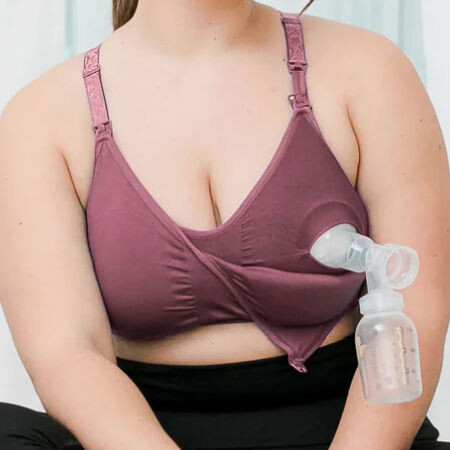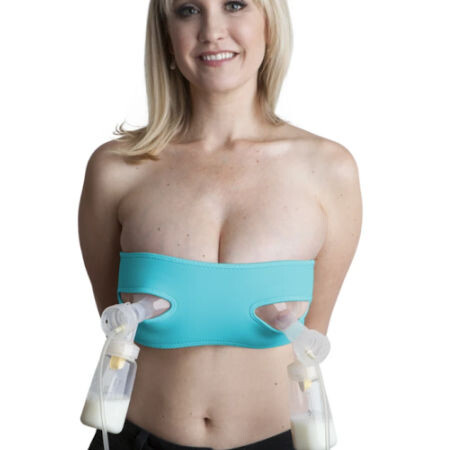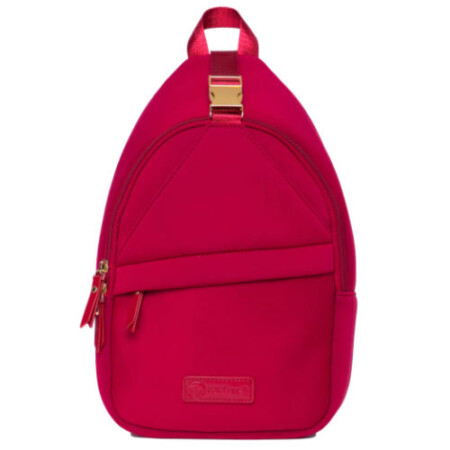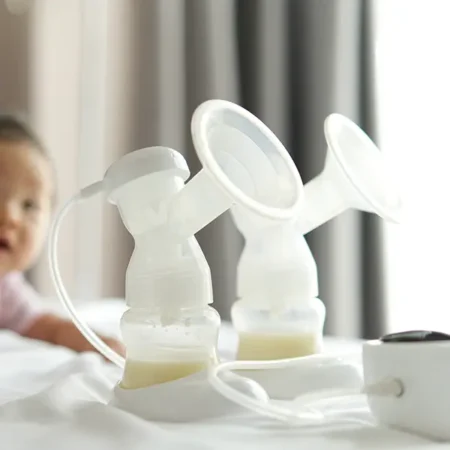There are a few reasons why you might want to combine breastfeeding and pumping – maybe you want to pump to start a freezer stash, or to increase your milk supply, or to collect milk for your baby while you’re at work. Here are some breastfeeding and pumping schedules you can use in each of these situations.

This post may contain affiliate links, which means if you click a link and purchase something, I may make a small commission at no additional cost to you. I only recommend products I love! More information here.
Nursing and pumping schedule – Building a freezer stash
Some women primarily nurse their baby, but also want to pump occasionally to build a freezer stash before they go back to work or for occasional separations from baby.
So how should you time your pumping sessions so that you can save a little extra milk, but still have enough to nurse at the next feeding?
Here’s a sample pumping schedule for a nursing mom who wants to create a freezer stash:
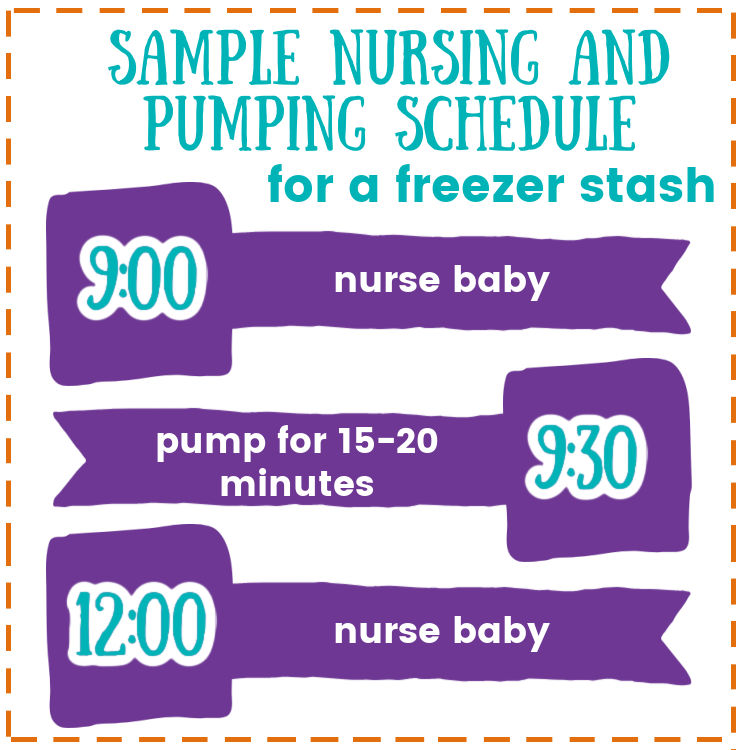
In this example, you would nurse your baby at 9am, pump shortly afterwards at 9:30am, and then nurse again at baby’s next feeding a few hours later around noon.
Obviously, you would adjust these times to fit whenever your baby nurses. For example, if she nurses at 10:15, you’d pump around 10:45, and then nurse whenever she’s hungry again a few hours later.
How to time your pumping sessions
You want to time it so that your pumping session starts shortly after you finish nursing your baby.
This way, you can express whatever extra milk is in your breasts after nursing, and then you have time for your breasts to refill with milk before the next feeding.
In the above example, you would nurse your baby and then pump about 30 minutes afterwards.
This gives you time to get your baby and yourself situated after you finish feeding, but not so much time that your baby will be wanting to eat again right after you’ve finished pumping (when your breasts won’t have much milk).
Length of pumping sessions
As far as the length of your pumping session goes, I would suggest aiming for about 15-20 minutes. Ideally, you’d get your milk to let down at least once, maybe twice.
Pumping longer than that (as a nursing mother) might lead to issues with oversupply or overactive letdown, so I would be careful not to overdo it.
How often to pump
If you’re working on building a freezer stash, I would suggest doing this schedule (nurse, pump about 30 minutes later, nurse for next feeding) one or two times a day. Again, overdoing it could lead to oversupply.
More on building a freezer stash here.
Hands-Free Pumping Bras
Breastfeeding and pumping schedule – Increasing milk supply
Some moms also pump in addition to nursing with the goal of increasing their milk supply.
This is because milk supply is driven by milk demand. If your body thinks that your baby needs more milk, it may respond by making more. Your breast pump can “demand” additional milk in place of your baby.
There are a few different ways that you can go about combining breastfeeding and pumping to increase supply.
1. Pump after nursing
One way is to do something similar to the schedule described above for building a freezer stash, where you pump about 30 minutes after you finish nursing.
So if baby nurses at 9am, you’d pump around 9:30 for 15-20 minutes, and then let your breasts refill for the next nursing session.
2. Power pumping
The other is power pumping, which looks like this:
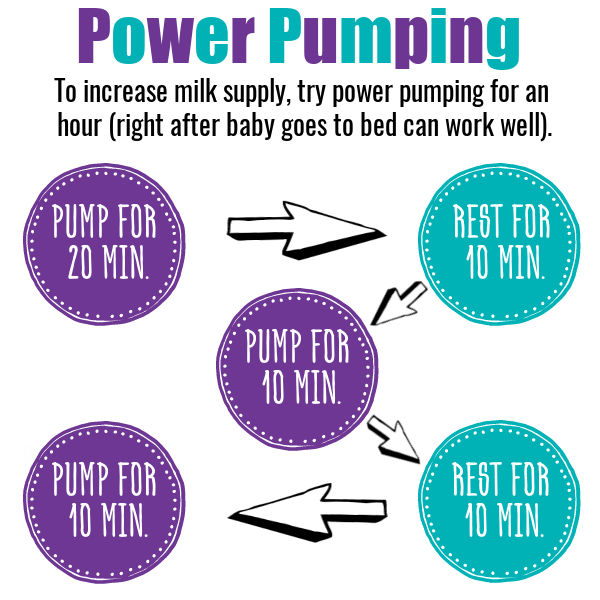
With power pumping, you pump on and off for about an hour, which simulates cluster feeding (where baby is constantly on and off the breast trying to get more milk).
I found it easiest to power pump after putting my baby to bed, both because that way I knew that I’d likely to be able to pump uninterrupted for an hour, and because I knew baby would likely not want to nurse again for a while.
Nursing and pumping schedule – Working mom
What about combining breastfeeding and pumping when you need to be separated from your baby while you work?
First, a big caveat on coming up with a schedule – a lot depends how old your baby is, as well as the nature of your job. For example, If you work 12 hour shifts as a nurse and have a three month old baby, your schedule will probably look a little different from a mom who is a teacher and has a nine month old.
Here’s a basic breastfeeding and pumping schedule for a working mom that you can use as a starting point:
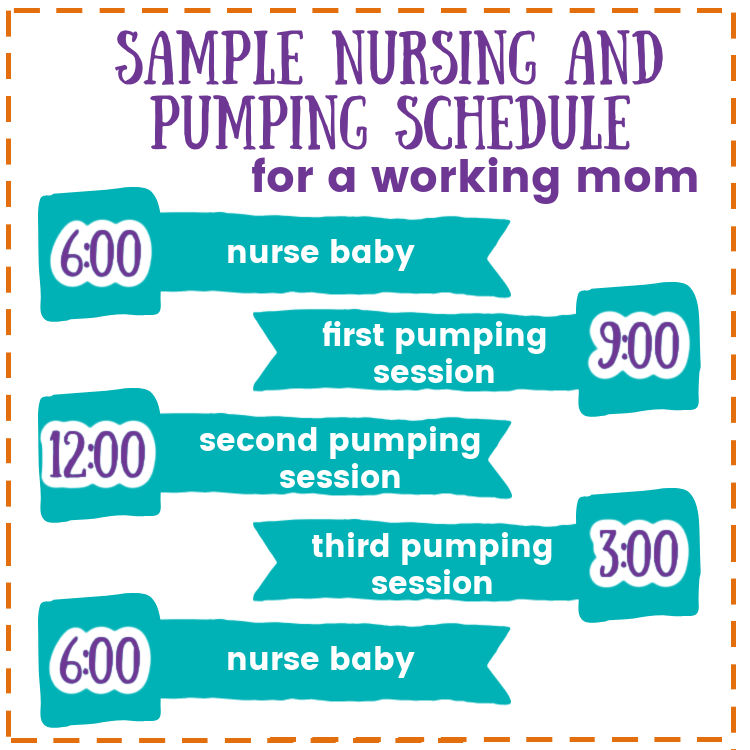
Timing nursing and pumping
Many women find that it works well to nurse baby first thing in the morning as well as for the first feeding after work, and then spread pumping sessions out as evenly as possible in between.
However, your circumstances might be different. For example, maybe you go to work very early, before your baby is awake. In that case, you could pump at 6am at home instead of nursing.
Or, maybe some days your baby has a bottle shortly before you get home, and isn’t hungry. In that case, you may want to pump for your own comfort when you get home instead of waiting to nurse.
Basically, just make sure you’re removing milk from your breasts about every three hours or so, whether it’s via your baby nursing or you pumping.
Breast Pump Bags
How often to pump and length of pumping sessions
The amount of times that you need to pump at work may depend on how old your baby is.
Younger baby
With a younger baby (less than six months old), I would try to pump about every three hours that you are separated.
So if you have a three month old baby, I would suggest pumping about every three hours for 15-20 minutes.
Older baby
If your baby is older, you may be able to experiment with pumping less often, but for a bit longer.
For example, if you have a 9 month old baby, you might find it works to pump every four hours for 20-25 minutes.
(When your pumping sessions are longer, you can usually get an additional letdown and pump more milk than in a shorter session.)
Much more on working and pumping schedules here.
I hope this helps you figure out the best breastfeeding and pumping schedule for you! Let me know in the comments if you have any questions.
References
- Bonyata, Kelly, IBCLC. “Forceful let-down.” Kellymom https://kellymom.com/bf/got-milk/supply-worries/fast-letdown/
- Pregnancy Birth and Baby. “Cluster feeding.” https://www.pregnancybirthbaby.org.au/cluster-feeding

